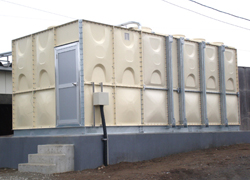Inquiries Concerning News
Corporate Communications Div.,
The Mitsubishi Chemical Group
TEL: +81-3-6748-7140
MPI Launches Nationwide Sales of Hishi Bio-tank Wastewater Treatment System
Jul. 6, 2009
| Mitsubishi Plastics, Inc. (head office: Chuo-ku, Tokyo; president: Hiroshi Yoshida) has developed Hishi Bio-tank™, a contact aeration* wastewater treatment system that eliminates excess sludge generated when treating wastewater from manufacturing processes for such foods as meat products, seafood, and canned and preserved foods. MPI will launch nationwide sales in July 2009. |  |
Currently, most of the wastewater from manufacturing foods and other products is treated using the activated sludge method. This method uses activated sludge bacteria to polymerize organic matter in wastewater, forming solids which settle to the bottom of the tank; the clean water at the surface of the tank can then be recycled and used as a municipal water source. This method, however, generates large volumes of sludge.
The excess sludge is normally drained and dried, then incinerated; some of it is converted into animal feed or compost. In any case, however, dealing with the excess sludge is very costly. Moreover, burying the sludge in a landfill or leaving it untreated will cause secondary harm, such as foul odors and the generation of toxic substances.
Dealing with this sludge using the conventional means poses other issues as well: Japan is running out of landfill space; incineration generates carbon-dioxide emissions; and discharging industrial waste is a major issue from the perspective of environmental conservation. Reducing the volume of sludge has therefore become a major challenge.
Operating the new wastewater treatment system is simple: customers simply need to install a compact Hishi Bio-tank (FRP panel tank), and connect it to their existing activated sludge treatment equipment.
The most suitable effective microorganisms are then placed in the Hishi Bio-tank™'s contact aeration tank; when wastewater from manufacturing processes is channeled through this tank, the microorganisms efficiently break down the organic matter, eliminating excess sludge. After breakdown, the treated water clears the target level for suspended solids (SS) defined by the Water Pollution Prevention Act by a large margin. After the water is returned to the existing activated sludge treatment equipment, it can be discharged.
The microorganisms also dissipate heat when they break down organic matter. This makes it possible to maintain a temperature suitable for the activation of the microorganisms without using an auxiliary heat source (even in winter), and ensures stable purification efficiency.
Since Hishi Bio-tank™ is installed above ground, it can be installed in a short period of time, and maintenance is easy as well. Hishi Bio-tank is easy to scale and relocate, and it can also be leased as a pollution prevention system in order to reduce the initial investment at time of introduction.
Introducing this system will make it possible to eliminate excess sludge, which is a type of industrial waste. The cost of introducing and maintaining the system can be less than the original cost of disposing of the excess sludge as industrial waste. The system will also help improve the environment in the operator's community, and establish a reputation as an environmentally conscious enterprise.
MPI will actively promote sales of the Hishi Bio-tank™ wastewater treatment system, and thereby aims to reach ¥2 billion in sales after five years.
Terminology
* Aeration
This is a process by which air is dissolved in a liquid, by blowing air molecules (e.g. oxygen) into a liquid, or by spraying dissolved gas in the liquid into the air. A typical example is dissolving air into wastewater, and supplying enough oxygen from the air to promote the breakdown action of aerobic microorganisms. There are several ways to achieve this state, including whipping air into the liquid; stirring the liquid so that air is drawn in from the liquid's surface; and spraying the liquid into the air so that the air and water dissolve together.
Contact aeration is a type of biofilm treatment process whereby a biofilm adhered to a catalyst in a contact aeration tank is used to catalytically reform and purify dirty water.
|
■Inquires regarding this material should be directed to the |
|
|
Public Relations Section, General Administration Dept., TEL: +81-3-3279-3800 |
|
